Following the crowd to better sound for less $$
“Just when I thought I was out, they pull me back in” – Michael Corleone, The Godfather Part 3
Michael Corleone must have been an audiophile.
There I was, about to receive my new Geek Out 1000 from the Kickstarter campaign when the good folks at LH Labs launched another crowd-funded endeavor on Indiegogo. And I had been patiently waiting for my GO1000. It was practically in the mail. But NO! “We have come up with another great idea!” The Geek Pulse, they called it. A Geek Out on steroids for your desktop pleasure.
“When they come, they come at what you love….”-Michael Corleone, The Godfather Part 3
Before I dig into the Pulse, here are a few words about Crowd Funding:
Crowd funding generally leads to a product being adjusted or modified from its original form during the process. That is part of the benefit to crowd funding; group customization. However, it can both delay the product past the originally anticipated release date as well as changing the product and its pricing into something different than originally advertised due to the requests and input from the crowd itself. (Such as the Geek Force, the registered participants on the http://lhlabs.com/force forums)
The end benefit is the supporters receive a significant discount from retail for their support and participation. In a sense you as a backer are accepting a certain level of development risk in exchange for a discounted final cost. Refunds may not be available as your contribution is being spent developing the product you had decided to support.
This is very different from our normal role as a consumer where we select and pay for a ready to go product and pay retail for the privilege of an immediately available and full tested product. One that may be returned for a refund later should we decide it is not what we wanted.
Who is Light Harmonic?
In 2010, Larry Ho founded light Harmonic in Sacramento, California. Larry had just finished creating the prototype for the Da Vinci DAC and his friends convinced him to take it to the marketplace. He had thrown everything he had into his new product and had enlisted help from fellow engineers in the US and Europe. Today the Da Vinci DAC is a highly regarded summit fi DAC yet is no longer their top end device. The Sire DAC at $120,000 has claimed that spot for now.
More info can be found about Larry and Light Harmonic HERE. And about the LHlabs approach to Crowd Funding concept HERE.
I asked Casey Hartwell, LH Labs Director of Digital Marketing, a few questions regarding their new product line:
- Eric Neff (EN): What prompted a High End company to move to the other end of the price scale?
- Casey Hartwell (CH): Larry & Gavin were showcasing Da Vinci at RMAF 2012 and were approached by a young man that asked if he could possibly listen to his own compilation of music (hip-hop, EDM, etc.) through Da Vinci in the listening room. Both of them happily obliged the request. The look of awe on the young mans face and the fact that he said “that was the best he’d ever heard his music sound. Too bad I’ll never be able to afford this” is what inspired them to embark on the mission of making the high-end audio experience affordable for everyone. From that, Geek Out was born and every other product has been influenced and designed around the same goal.
- EN: What drives a product development decision? See a niche? Have a great idea?
- CH: We’re huge crowd-design advocates. We present the crowd with our ideas and ask them to help us make it better and more useable. We’ve found that when we launch a product the crowd has so many great ideas it’s like having a team of 1,000+ designers helping to make our products perfect.
- EN: Considering the forthcoming Keep Mono Block amps and the Soul, is the goal to provide a full system at some point?
- CH: That could be a goal 😉
- EN: When people think of Light Harmonic or LH Labs what do you want to be the top thing coming to mind? What does the brand stand for in your mind?
- CH: For LH Labs & Light Harmonic we want to be seen as being different. We want to be known as a company that is not full of BS. We test whatever we do and are able to provide the concrete evidence around every product we produce. There is no marketing spin and no empty promises. We deliver only the best gear, without compromise.
- EN: Do you anticipate Crowd funding to be your primary development-funding model going forward?
- CH: Yes. It allows us the opportunity to not only develop our products through crowd-design but to ultimately make a larger splash outside of such a niche industry. We love making our products for audiophiles but we love it even more when we are able to introduce non-audiophiles to our products and expose them to the world of audio that they didn’t even know they were missing.
Product Specs
Generally, product specs are straightforward and simple to list. In the case of the Pulse the variations can confuse.
So, there are 3 versions of the Pulse:
The Geek Pulse $999 retail ($399 while the Indiegogo campaign is open)
LH Labs Description – “This is what others might call a base model, but we prefer to think of it as where awesome starts.”
The Geek Pulse X $1799 retail ($777 while the Indiegogo campaign is open)
LH Labs Description – “This is a fully-balanced, dual mono version of Geek Pulse. On the front, in addition to the 1/4″ stereo headphone jack, you get a four-pin balanced headphone output. On the back, there’s another way for your stereo: a pair of balanced XLR outputs.”
The Geek Pulse X-Fi $3199 retail ($1399 while the Indiegogo campaign is open)
LH Labs Description – “This is Geek Pulse X on steroids. Remember that optional dual Femto clock upgrade? This is where you get it. It also has upgraded passive components (capacitors and resistors) as well as upgraded active components (opamps and controllers).”
Geek Pulse measures at a depth 8.25 inches, width of 7.375 inches and height of 3 inches.
A complete description of the specs comes from the LH Labs Geek Pulse chart:
Chart courtesy of LH Labs – Specs are subject to change
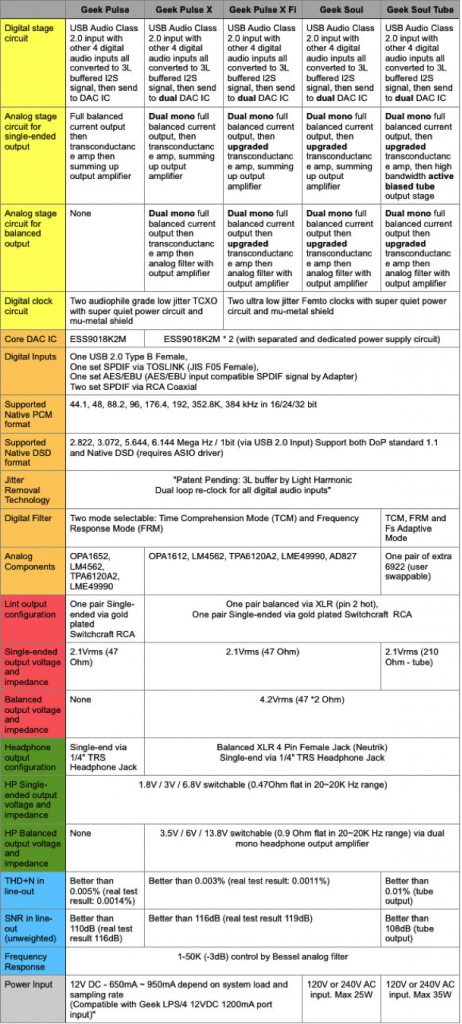
Note that all versions of LH Labs and Light Harmonic DAC’s process all digital music in its native format. DSD stays DSD as opposed to many DAC’s, which convert DSD to PCM for playback. In addition to the choice of DAC’s they also offer a companion Linear Power Supply that comes in two versions.
The LPS $899 retail ($529 while the Indiegogo campaign is open)
LH Labs Description – “This is Geek Pulse’s linear power supply buddy that we told you about earlier. It has one 120 or 240 volt AC input, one 12 volt DC output, one USB input, and one USB output.”
The LPS 4 $1299 retail ($639 while the Indiegogo campaign is open)
LH Labs Description – “This is just like Geek LPS, but it has four 12 volt DC outputs instead of just one. It’s perfect for other audio gear you might have that uses 12V DC power.”
What formats can the Pulse handle? How about any of them currently available from basic Redbook CD 16/44.1 to 24/384 as well as DSD64 and DSD128? As usual a driver is required for Windows use. No driver is needed for Mac use.
The Geek Pulse has several selectable settings accessed via the volume knob on the front. Pressing the knob brings up the selectable menu.
- Input – USB, AES, SPDIF 1, TOSLINK, SPDIF 2
- Gain Select – Low, Medium, High
- Digital Filter – TCM (Time Comprehension Mode), FRM (Frequency Response Mode)
- Volume Setting – Knob Control, USB
- Firmware Version Display – Currently Ver. 1.0
The gain setting is handy as it allows for IEM use with a dead quiet background in Low, or set to high for the fill 3 Watts of output for those hard to drive low impedance cans.
Usually when reviewing an audio product there are a couple of sonic considerations. One is does it sound good? And the second is does it sound good “For the Money?” In this case we have two price points due to the open crowd funding option on Indiegogo.
The qualities I have experienced make the Geek Pulse a great buy at its projected retail price. At the crowd-funding price it is a flat out steal.
Review perspectives and caveats:
I am not going to include an LPS commentary in this review. I had a ton of questions on the forums about the LPS and all of its connectivity uses. There is a list of information on the LHLabs.com web site relating to the LPS. Given the variety of power grid quality as well as the many components people will use with the Geek Pulse and LPS, I cannot adequately cover that ground under my deadline commitments. Time, and too much variable iteration make that too large a challenge. However, I cannot imagine with high-resolution audio that adding clean power would not be in the listener’s best interest. I also believe in giving the best circumstances to gear as possible. So, I will be using the Light Harmonic Lightspeed cables and Stillpoints vibration control devices for best possible results.
Listening
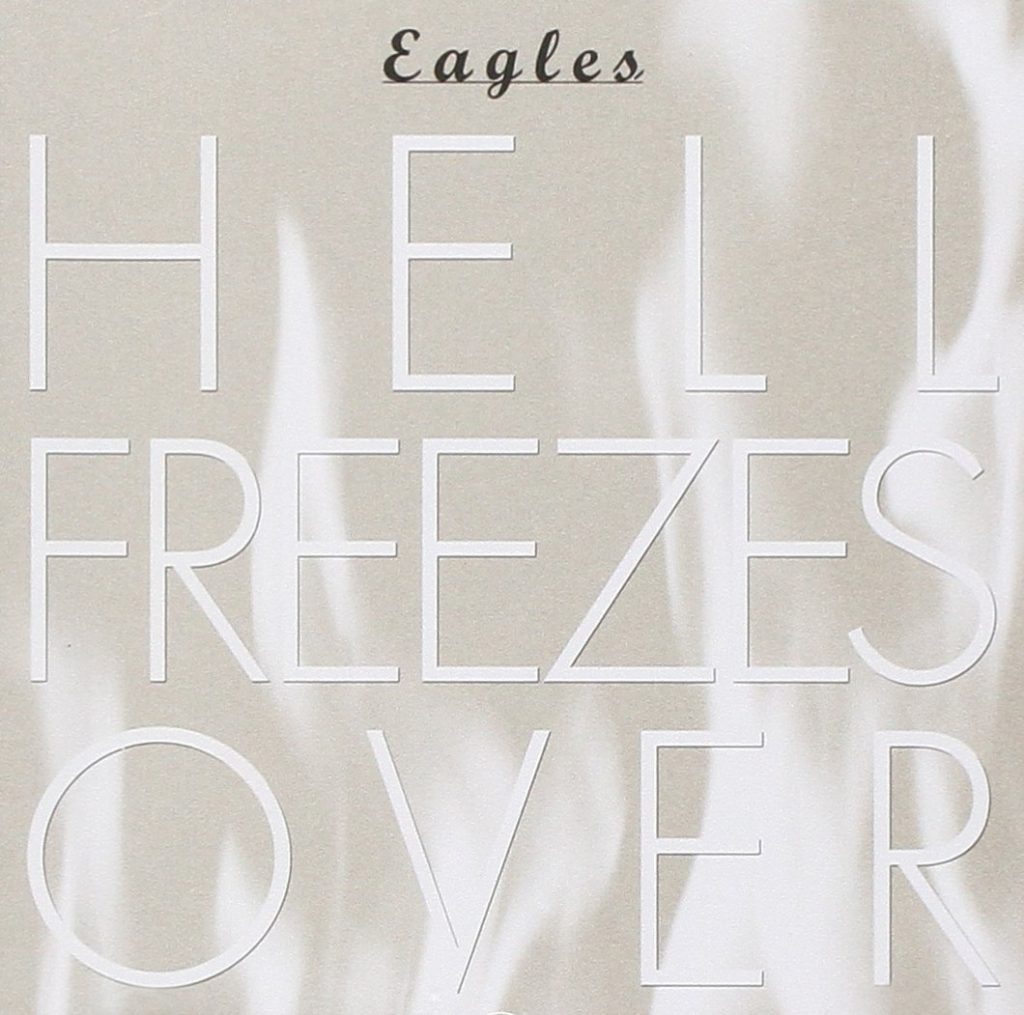
First up on the hit list is The Eagles “Hotel California” via CD Rip AIFF 16/44.1 1411 kbps. OK. So it gets used a lot. I love this song and this particular rendition. The space in the Hall for this live performance is tough to reproduce with headphones. I always enjoy sitting near the front of the Hall. You easily achieve this sense with the Pulse. Wide-open and spacious, the concert hall opens up in your mind and keeps expanding outward. The opening notes contain the delicate sounds of fingers on strings as the song unfolds. Fretwork is clean and the sliding of fingers up and down the neck trace sonic pathways between the notes. Percussion floats airily in the background providing a base to the guitars lead. Don Henley’s vocals center the performance. The bass guitar adds a strong foundation throughout the song.
Compared to my reference rig, the Cary SLI-80 with F1 Mods and the Wyred 4 Sound DAC2 DSDse I experienced similar detail and top end openness. Both DAC’s use the ESS Sabre 9018 chips. Perhaps the Cary and W4S provided a bit more space and some warmth that the Solid State Pulse would not inject. Tube effect perhaps? Both were wonderful listening sessions. Your preference here could go either way. Considering the Cary/W4S combo clocks in at almost 2X the Pulse/LPS combo’s cost, it was a good showing for LH Labs.
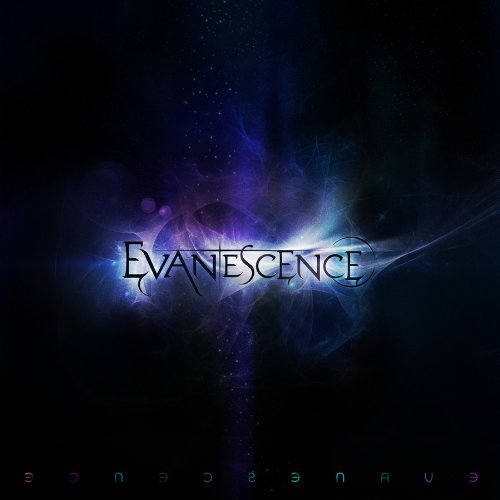
Next up Evanescence, Made of Stone. CD Rip 16/44.1 AIFF 1411 kbps. This is a great track that happens to be highly compressed in post-production. It is hard to pull the layers out given the compression. Drums, bass and rhythm guitar are heard as individual as I have experienced. This is tough to accomplish since they seemed to have been engineered as a wall-of-sound. It is worth the effort, as Amy Lee kills it with this track. Her high notes are exquisite. Here is where the Pulse does a great job of separating the parts and providing a nice coherent package back. Amy and the boys always provide great energy and it comes through via the Pulse. Volume is no trouble as I could make my ears bleed at medium level.
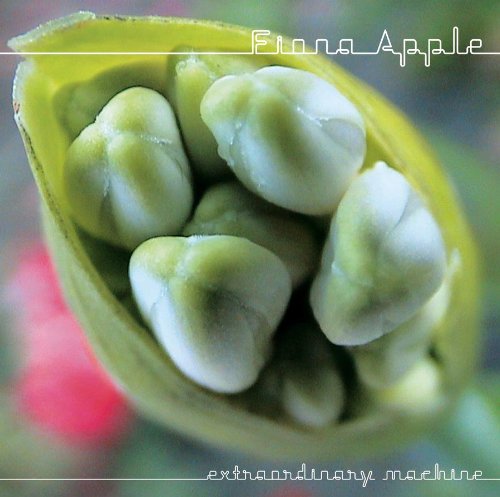
Fiona Apple’s Extraordinary Machine has that club vibe. CD Rip 16/44.1 AIFF 1411 kbps. The song, “Get Him Back”, presents an intimate space. You can visualize Fiona at her mic with the band around her. Her voice fronts the drums and piano. They can easily be perceived as being behind and to the right of her in the track. Cymbals shimmer, as they should over the top. I have a nice table upfront in the club. One of my favorite listening metaphor’s is “Did I see the smoke in the club?” Michael Mercer would call it: Gestalt. It is the physicality or three-dimensionality of the listening experience. The pulse provides that experience. For me that is a “must have” part of the package.
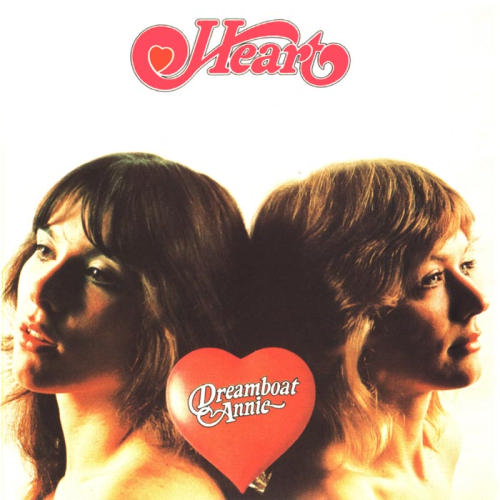
Moving to higher resolution I queued up Heart’s Dreamboat Annie at 24/192 AIFF from HDTracks.com. Clean. I have listened to this album since it’s release in 1976. This release cleans up the hash (wrong example for a 70’s record?) and what you hear is a layered presentation. Each part can be heard clearly without any interference between layers. It is like being inside a snow globe with perfectly clean water inside. All sides of the music can be enjoyed from all points without any noise to obscure the presentation. This gives me some insight into the quality of DAC implementation from LH Labs. You would not be able to look through the music so clearly without a first class DAC and top-level implementation. Overall the Pulse provided a beautiful presentation and one that led me to listening to the entire album before I realized it.
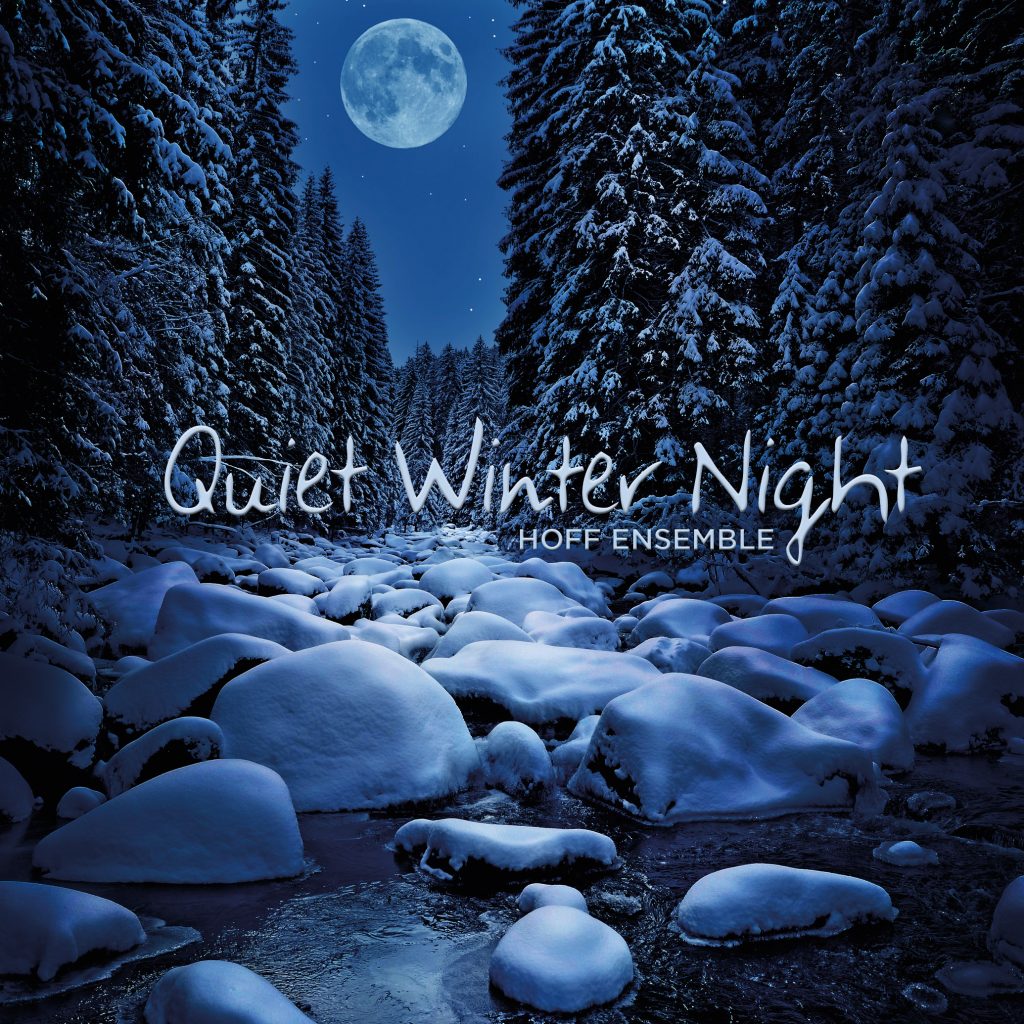
Moving to the top of the resolution scale I went to the Hoff Ensemble of Norway’s “Quiet Winter Night –an acoustic jazz project” from www.2L.no. This performance was recorded in DXD 24/352.8. I am listening to the DSD128 version available from 2L’s website. My Norwegian is very rusty (OK, I married a Lady of Norwegian heritage, but I can’t speak a bit). The clarity and spaciousness of the recording is breathtaking. Piano is always a reference for me. My father is a professional musician and I grew up listening to him play in many venues. Listening to the attack of the strike on the strings it was life-like and the decay was as it should be. Sustain and timbres are appropriate. This is a joy to experience. Once again, if Larry and his team at LH Labs had not done their job then there would be plenty to distract from enjoying the performance. I feel small ensemble pieces are harder to reproduce because there is no place to hide a problem. Not enough trees in that forest as it were. A big thumbs up in this regard.
Conclusions
I was having a conversation with a good friend who is a long time owner of a high-end audio shop. He carries some of my favorite aspirational gear and we have spent many hours auditioning his stock. We were discussing a well-regarded speaker and he made the comment that you could pick apart the music with the speakers but it seemed too surgical. The parts were all individual and not part of a whole. The sound “lacked coherence”. I have to agree. I felt the same way about those speakers. And they are not the first pair that gave me that same experience. High end is not about pulling things apart. It is about presenting them as a whole in the best light the gear can manage. It is a function of all the parts of the system chain.
I am very familiar with my HD800’s and the rest of my reference gear. Substituting new equipment is always interesting. Discerning the nuances of a change always make for a fun night in the listening room. Yet sometimes those new parts are not the best. They may be fine with other components in a new chain, but they are not always right with mine.
In the case of the Geek Pulse X-Fi with LPS, I have a winning combination. Gear that integrates easily with my other components and yet brings it’s own flavor to the event. Being a tube fan I sometimes struggle to find solid-state gear that I could live with. The Geek Pulse would easily make that short list. I also applaud the ESS Sabre 9018 implementation. It seems to be a tricky chip to wrestle into place. Mission accomplished for the LH Labs team!
The Indiegogo campaign has been reopened. You can find it HERE.
Pros
- Hi Rez audio powerhouse in a small chassis
- Accepts all major digital inputs
- Native DSD
- Accepts all popular digital file types
- Single Ended and Balanced (4 Pin) Headphone outputs
- High-end sparkle, sweet Midrange and Low-end slam are all present
- Great value at it’s retail price, a steal during the IGG campaign
Cons
- Device style is basic black with no bling
- Device must be on and be selected as the active sound device prior to opening Amarra or Audirvana+
- If you want to isolate the USB power via the LPS you will need two USB cables. Keep the total length less than five meters or the signal may be unstable. (This is really a USB issue, not a Pulse/LPS issue)
Associated Equipment
- Cary SLI-80 Integrated Amp
- Wyred 4 Sound DAC2 DSDse with Femto Clock
- Sennheiser HD800 Headphones with balanced Toxic Cables Silver Widow’s
- Sennheiser HD650 Headphones with Single Ended Toxic Cables Silver Poison’s
- Beyer DT1350 Headphones
- JH Audio JH16 FP CIEM’s with Toxic Cables Silver Widows
- ACS Custom T1 CIEM’s
- Light Harmonic 10G Lightspeed cable
- Light Harmonic 1G Lightspeed cable
- Stillpoints Ultra SS
- Stillpoints Ultra 5 with Ultra Base
- Amarra 3.03
- Audirvana+ 1.5.12
Music sourced from a MacMini Late 2012 2.3 GHz i7 with 16 G Ram














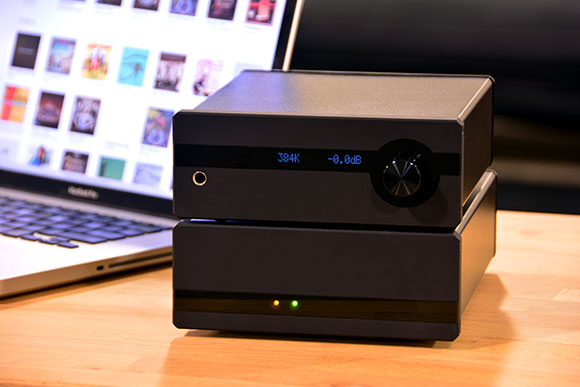
Reply
Reply
Want to join discussion?
Feel free to contribute!